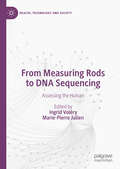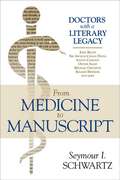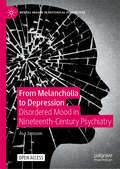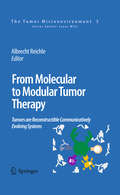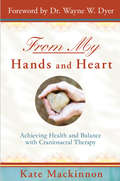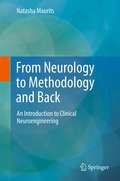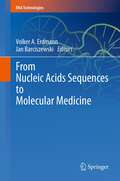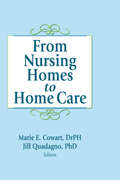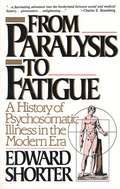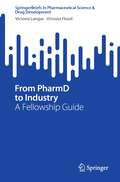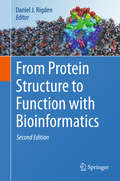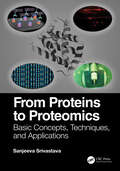- Table View
- List View
From Management to Leadership
by Jo ManionFrom Management to Leadership identifies the fundamental interpersonal skills that every health care leader (and aspiring leader) needs to develop in order to be a successful executive or manager. The third edition of the classic text offers suggestions for developing and improving essential health care leadership skills. Written to be a practical guide, the book presents concepts and skills that can be immediately applied to everyday situations. Completely revised and updated, this edition includes new concepts and resources based on the latest research and practices. Praise for the Third Edition of From Management to Leadership "As leaders, we want engagement, commitment, ownership, teamwork, and results. Jo Manion illuminates the interpersonal skills that are pivotal. She provides the how in a way that's convincing, refreshing, mind-stretching, and practical. " -Wendy Leebov, EdD, president, Wendy Leebov and Associates "This third edition continues the tradition of enumerating the incisive and articulate response of leaders to the complexities of the age and of the necessary recalibration of the leader's role. I encourage contemporary leaders to see this text as a must have in their leadership library: I certainly have it in mine!" -Tim Porter-O'Grady, DM, EdD, ScD(h), APRN, FAAN, senior partner, Tim Porter-O'Grady Associates, Inc. and associate professor, College of Nursing and Health Innovation, Arizona State University "Finally, a book that addresses the need for health care leaders and aspiring leaders to be much more than good managers. This book gives practical, concrete, and insightful strategies to becoming a great leader. " -Katherine W. Vestal, RN, PhD, FACHE, FAAN, president, Work Innovations LLC Companion Web site: www. josseybass. com/go/manion
From Measuring Rods to DNA Sequencing: Assessing the Human (Health, Technology and Society)
by Ingrid Voléry Marie-Pierre JulienThis book provides a solid basis to understand two centuries of bodily measurement practices and their scientific and political scope throughout the Western world. By exploring various cases, it proposes a new approach of measurement from an epistemological point of view and demonstrates the central role of the measurement of the body for political purposes. By studying categorizations of race, age and quality of life between the 19th and 20th century, the first part of the book highlights how human body measurements extend from the flesh to subjective experience. The second part shows how genomic correction and life support technologies reshape the frontiers between things, humans and social subjects. The final part reveals how contemporary measurements of age, race and disease gave rise to new hierarchies between human beings and social groups. The book concludes by considering different styles of measuring the body and their ontological consequences.
From Medicine Man to Doctor: The Story of the Science of Healing
by Howard W. HaggardCompelling and informative, this overview of medical history traces modern-day medical practices from their roots in the ancient civilizations of Egypt, Greece, and Rome. Physician Howard W. Haggard — a popular lecturer, prolific author, and Yale professor — specialized in explaining health-related issues to ordinary people. This 1929 survey offers fascinating facts and anecdotes from around the world in its chronicles of the development of obstetrical methods, anesthesia, surgery, drugs, and other landmarks in the science of healing.The first chapters examine the treatment of child-bearing women throughout the centuries, from practices related to the legends of Aesculapius and Hygeia to the long battle against puerperal fever, the invention of obstetrical forceps, and the rise of anesthesia. A profile of the progress of surgery explores the violent opposition to early attempts at studying anatomy through human dissection, and the gradual adoption of antiseptic principles. Quarantine, vaccination, and a heightened public awareness are cited among the record of attempts to conquer plague and pestilence.Final chapters investigate faith healing through the ages and occult practices such as exorcism and the trade in holy relics; herb doctors and medieval apothecaries; the recognition of bacteria as a cause of infectious disease; and the eventual trend away from treatment and toward prevention.
From Medicine to Manuscript: Doctors with a Literary Legacy
by Seymour I. SchwartzAn eminent surgeon, who has written books on the history of medicine and cartography, profiles physicians past and present who have also published works in the humanities. Throughout history doctors have felt the need to express themselves in prose and poetry, often on subjects far removed from their medical interests. Renowned surgeon Seymour I. Schwartz felt this same compulsion to write and eventually decided to investigate other authors with a background in medicine. The result is this informative and entertaining compilation of biographical profiles spanning the Middle Ages to the present era. In many cases, literary fame has eclipsed memory of these authors' medical expertise: Most people today talk about Maimonides, Rabelais, Locke, Schiller, Keats, Conan Doyle, and Chekhov because of their literary works, not because they practiced medicine. But the lesser-known individuals are just as interesting in many ways: such people as Cadwallader Colden, the loyalist lieutenant governor of New York during the American Revolution, who wrote the first English history of the Iroquois; Margaret Georgina Todd, author of popular novels in the Victorian era, which promoted the idea of women in medicine; and Rudolph John Chauncey Fisher, who was not only a physician, researcher, and radiologist, but played a role in the Harlem Renaissance as an orator, musician, musical arranger, and literary figure. Concluding with profiles of contemporary doctors who are also respected authors, this diverse collection shows that, despite increasing specialization, medicine and the humanities continue to complement each other to enrich our lives.
From Melancholia to Depression: Disordered Mood in Nineteenth-Century Psychiatry (Mental Health in Historical Perspective)
by Åsa JanssonThis open access book maps a crucial but neglected chapter in the history of psychiatry: how was melancholia transformed in the nineteenth century from traditional melancholy madness into a modern biomedical mood disorder, paving the way for the emergence of clinical depression as a psychiatric illness in the twentieth century? At a time when the prevalence of mood disorders and antidepressant consumption are at an all-time high, the need for a comprehensive historical understanding of how modern depressive illness came into being has never been more urgent. This book addresses a significant gap in existing scholarly literature on melancholia, depression, and mood disorders by offering a contextualised and critical perspective on the history of melancholia in the first decades of psychiatry, from the 1830s until the turn of the twentieth century.
From Menarche to Menopause: The Female Body in Feminist Therapy
by Joan ChrislerFrom Menarche to Menopause: The Female Body in Feminist Therapy examines the latest research on the menstrual cycle and women&’s reproductive health. This timely volume focuses on women in therapy who are disconnected from-or even repelled by-their own bodies due to cultural attitudes, abuse, trauma, or the natural aging process. Experts in the fields of psychology and women&’s health unite to celebrate the physical life stages of women and girls and to offer practical advice for therapists to use when addressing negativity caused by appearance, age, menstrual symptoms, or reproductive concerns. In this book, you will gain new understanding about the effects on a woman&’s mental health that transitional life stages can cause, from preadolescence through the childbearing years to menopause. The suggestions in From Menarche to Menopause can help women resist the bombardment of negative messages and misleading information they receive about their bodies and their reproductive concerns. This helpful resource can also assist you in opening new lines of communication between mothers and daughter, women and men, and women and other women. From Menarche to Menopause discusses how to handle topics such as: self-loathing caused by media and cultural messages that affect women&’s acceptance of their bodies overcoming a daughter&’s reluctance to discuss sensitive topics of bodily maturation, menstruation, and emerging sexual development helping women, men, and couples cope with infertility assisting women in overcoming a disappointing birth experience providing therapeutic care to women and couples who experience perinatal loss addressing perimenopause in midlife women and the concerns, negative attitudes, and uncertainty of this transition This unique book fills the gap in feminist therapy literature with practical advice concerning the functions of women&’s bodies that can be used within the therapy context. From Menarche to Menopause includes extensive references and several book reviews to further your research and provide reading and other resources you can recommend to your clients. This practical resource on women&’s reproductive health-as it relates to mental health-is an important addition to the bookshelves of feminist psychologists, clinical practitioners, social workers, and health practitioners as well as faculty and students of these disciplines.
From Midwife to Mommy (Harlequin Lp Medical Ser. #Vol. 1038)
by Deanne AndersThe family she’s always wanted…With the man she doesn’t expect!Midwife Lana Sanders is about to adopt little Maggie, and gain the family she never thought she’d have, when pediatrician Trent Montgomery arrives claiming to be Maggie’s uncle! Lana won’t give up without a fight, but resisting the tempting Texan is her greatest battle. They work well together in the delivery room and sparks fly in the bedroom, but can Lana trust Trent with her heart?
From Molecular to Modular Tumor Therapy:
by Albrecht ReichleThe traditional problem of the poor presentability as well as diagnostic and therapeutic practicability of individual patient care is still unresolved. The present book aims at leading the reader (cancer researchers, pharmacologists, biologists) away-in a scientifically accessible manner-from the daily conflicts between theory and practice and between the generalized and individual tumor patient, so that more personalized diagnostic and therapeutic strategies can be developed for controlling metastatic tumor disease: * First, recording the systems concept of tumor biology based on rather different sciences (biochemistry, cell biology, and medical oncology) including their potential contribution to communication, * then, giving reductionistically derived systems features an internal communicative context (formal-pragmatic communication theory), and * finally, binding the systems features to (tumor-immanent) evolutionary processes (modularity of biochemical and cellular processes,rat.
From My Hands and Heart: Achieving Health And Balance With Craniosacral Therapy
by Kate MackinnonCraniosacral therapy (CST) is a powerful hands-on treatment that supports the body's own wisdom and innate ability to heal. Tens of thousands of practitioners around the world can attest to the effectiveness of this rapidly growing therapy. In From My Hands and Heart, Kate Mackinnon interweaves her personal journey of using CST with case studies and detailed, easy-to-understand explanations of the theory behind it. Whether you've never heard of CST before, thought it didn't apply to you, or are currently undergoing treatments, this book has something for you. Mackinnon guides you through creating a team of practitioners focused on your well-being, and explains how to help yourself at home between sessions. You'll learn simple, safe techniques that almost anyone can perform and receive. Most important, you'll gain a deeper understanding of the amazing powers of the human body and how, with individualized support through CST, it can find its own way to balance and health.
From Neurology to Methodology and Back
by Natasha MauritsIn today's hospitals, the gap between technology and medicine constantly needs to be bridged, both by physicians and engineers. By taking a unique clinical neuroengineering approach, From Neurology to Methodology and Back offers a translational study of neurology and technology from both sides. The fundamental topics covered range from basic concepts such as sampling and simple statistical measures via Fourier analysis to source localization. Providing clinically relevant context and introduce technical concepts, the neurological diseases presented range from epilepsy, brain tumors and cerebrovascular diseases to tremor, MS and neuromuscular diseases. All topics are presented in a true clinical neuroengineering approach. Each chapter begins with one or more patient cases for inspiration. Each case is then presented to illustrate a working example of a distinct neurodiagnostic technique, and the mathematical and physical principles underlying these techniques are explained. Finally, the author returns to the patient, and examines how the presented technology can help provide a diagnosis for each case. From Neurology to Methodology and Back serves as an upper-undergraduate/graduate level guide for those interested in a translational approach between the fields of medicine and technology in neuroengineering. Neurologists and residents in neurology, medical engineers, medical students, biomedical engineers and students, technical medicine students or students of other interdisciplinary fields will therefore all find this book useful. Each chapter begins with one or more patient cases for inspiration. Each case is then presented to illustrate a working example of a distinct neurodiagnostic technique, and the mathematical and physical principles underlying these techniques are explained. Finally, the author returns to the patient, and examines how the presented technology can help provide a diagnosis for each case. From Neurology to Methodology and Back serves as an upper-undergraduate/graduate level guide for those interested in a translational approach between the fields of medicine and technology in neuroengineering. Neurologists and residents in neurology, medical engineers, medical students, biomedical engineers and students, technical medicine students or students of other interdisciplinary fields will therefore all find this book useful.
From Now Until Forever
by Rowan Coleman'A writer I'd follow anywhere' KATIE FFORDEFrom the Sunday Times bestselling author of The Memory Book, an unforgettable, beautiful novel about what it means to live to the fullest and to love forever.He's running out of time.Ben Church has never done anything extraordinary in his life -- until now. Now, he needs to fulfil as many of his dreams as possible while he still can.That's why he's standing in front of his favourite painting by Leonardo da Vinci when he should be at work. Time is all she has.Vita Ambrose's life of parties and fabulous clothes looks wildly glamorous but in reality it has no meaning. She's seen too much, lived too much and lost too much. That's why she's come back to the gallery, to seek solace in her favourite painting.Together, can they make time stand still? Ben and Vita's connection is immediate, spontaneous and passionate. But the clock is ticking. Can they find a way to make their love live forever? Because every moment matters when it might be your last . . .(P)2023 Hodder & Stoughton Limited
From Now Until Forever
by Rowan Coleman'A time-travelling delight' EVE CHASE'A delightful dream of a book' LISA JEWELL'An incredible story of love and hope' KATIE FFORDE'Gloriously romantic and deeply moving' LUCY DIAMOND'A book you will carry with you long after the last page' MILLY JOHNSON'Up there alongside The Time Traveler's Wife' CAROLE MATTHEWSFrom the Sunday Times bestselling author of The Memory Book, an unforgettable, beautiful novel about what it means to live to the fullest and to love forever, for fans of The Time Traveler's Wife, Me Before You and Outlander.He's running out of time.Ben Church has never done anything extraordinary in his life - until now. Now, he needs to fulfil as many of his dreams as possible while he still can.Time is all she has.Vita Ambrose's life of parties and fabulous clothes looks wildly glamorous but in reality it has no meaning. She's seen too much, lived too much and lost too much.Together, can they make time stand still? Ben and Vita's connection is immediate, spontaneous and passionate. But the clock is ticking. Can they find a way to make their love live forever? Because every moment matters when it might be your last . . .MORE PRAISE FOR FROM NOW UNTIL FOREVER'Beautiful' LOUISE BEECH'Life-affirming and joyful' SARA SHERIDAN'Wonderful . . . both emotional and utterly captivating' JILL MANSELL'A stunning book about what it takes to be truly alive' JULIE COHEN'Captivating and completely unforgettable, Vita and Ben's love story made me believe the impossible might not be so far out of reach' JULIETTA HENDERSON'A fabulous, heart-breaking, uplifting love story that just goes to show time might not always be on our side, but love always wins out.' DAVID BARNETT
From Nucleic Acids Sequences to Molecular Medicine
by Jan Barciszewski Volker A. ErdmannDespite a half century of structural, biophysical and biochemical investigations of ribonucleic acids, they are still mysterious. RNAs stand at fertile crossroads of disciplines, integrating concepts from genomics, proteomics, dynamics as well as biochemistry and molecular biology. From 20 years it is clear, that genetic regulation of eukaryotic organisms has been misunderstood for the last years that the expression of genetic information is effected only by proteins. Basic understanding of nucleic acids has enhanced our foundation to probe novel biological functions. This is especially evident for RNA molecules whose functionality, maturation, and regulation require formation of correct secondary structure through encoded base-pairing interactions.
From Nursing Homes to Home Care
by Jill Quadagno Marie E CowartOlder people who would prefer to stay in their homes and states whose funds are being depleted by the rising costs of Medicaid payments to nursing homes find the current system of long-term care unsatisfactory. From Nursing Homes to Home Care arms educators, policymakers, public health professionals, gerontologists, and advocacy groups with the information they need to participate knowledgeably in the debate about aging and long-term care needs. The book shows readers where things are, where they are going, and where they need to be in changing the system of long-term care. From Nursing Homes to Home Care evaluates future needs for long-term care by analyzing on-going systems and assessing key features of proposed long term programs in the context of population aging. Readers gain a thoughtful analysis of the complex dimensions of making future long-term care policy and program decisions as they read about: patterns of demographic aging, disability, and health needs intersections of formal and informal care including intergenerational equity issues long-term care services needs and accessibility planning for funding, quality assurance, and range of services implications of shifts from the current system to a system of home and community-based services Chapters in From Nursing Homes to Home Care express the collective thinking of leaders in long-term care policy and research. Contributors address implications for changing the current system in relation to the emerging needs of the aging population and use this as a basis for examining alternative decisions. Information in the book helps readers determine how to best blend formal and informal services, how to assure quality of care and quality of life in long-term care policy, how to finance devised programs, which health needs to address, and whether to use regulatory or competitive approaches. Professionals, educators and students, and policymakers at all levels learn about factors to consider in policy planning and decision making, including features of aging baby boomers; trends in the growth of the aged population; newly emerging trends in morbidity, disability, and mortality and their effect on the demand for long-term care in the short and long term; access issues from the perspective of the historical evolution of publicly funded long-term care services, the distribution of formal and informal systems of care; utilization patterns of the minority and poor; how to pay for care, how to design an appropriate mix of services, how to maintain quality with efficiency, and how to mesh services with social and family values. From Nursing Homes to Home Care is an invaluable resource in evaluating and advocating policy changes and decisions for an improved long-term care system.
From Obesity to Diabetes (Handbook of Experimental Pharmacology #274)
by Karine Clément Juergen EckelObesity is a major risk factor for the development of type 2 diabetes and its associated complications, a major socio-economic burden for health care systems. The worldwide prevalence of obesity doubled since 1980 and as a consequence the number of patients with diabetes has been continuously rising with more than 450 Mio. people suffering from this disease at the present time. Substantial progress has been made in understanding the molecular pathways leading from excessive fat accumulation to metabolic perturbation and finally diabetes manifestation. This edition of the "Handbook of Experimental Pharmacology" aims to analyze new insight into the pathophysiology of obesity, to decipher the complex links to diabetes and its complications, and to collect most recent information on new strategies for prevention and treatment of obesity and diabetes.
From Oncology Nursing to Coping with Breast Cancer: My Journey There and Back
by Kate HaywardMany healthcare professionals that I've encountered refer to a patient's cancer journey; indeed I had an article published describing a patient's journey through biological therapy. This particular case history described my involvement with a medical doctor's experience of renal cell carcinoma and self-administration of immunotherapy. He was very keen to share his experience to educate and inform other health professionals and I now find myself in a similar situation.'I have 'journeyed' from nurse to patient when diagnosed with grade 3-breast cancer. Of course, I've experienced various health problems before this time, but I never spent a night in hospital, unlike members of my family who have experienced serious illness and hospitalisation on several occasions. Consequently I've always regarded myself in the caring role amongst family members and over the years I've used my nursing knowledge and skills to help them deal with both the physical and psychological issues of their various disease processes. However, being diagnosed with breast cancer has now changed me from nurse and carer into a vulnerable ill person with doubts and fears for my future. To restore some sense of purpose while on sick leave and help me to get through each treatment stage, I decided to keep a daily journal of my experience.
From One Cell: A Journey Into Life's Origins And The Future Of Medicine
by Ben Stanger“Insightful and erudite.”—Adrian Woolfson, Wall Street Journal Inside the quest to unlock the mysteries of development—and find the key to transforming our future. Each of us began life as a single cell. From this humble origin, we embarked on a risky journey fraught with opportunities for disaster. Yet, amazingly, we reached our destination intact, emerging as dazzlingly complex, exquisitely engineered assemblages of trillions of cells. This metamorphosis constitutes one of nature’s most spectacular yet commonplace magic tricks—and one of its most coveted secrets. In From One Cell, physician and researcher Ben Stanger offers a breathtaking glimpse into what scientists are discovering about how life and the body take shape, and how these revelations stand to revolutionize medicine and the future of human health. In vivid prose, Stanger leads readers on a gripping odyssey retracing this universal, yet unremembered, rite of passage. Through the eyes of the scientists unraveling development’s riddles in experiments as painstaking as they are inventive, we confront fascinating puzzles: how does the plethora of different tissues that compose our bodies arise from a single source? How do cells know what they are meant to become—skin or bone, blood or muscle—when all carry the same set of genetic instructions? Once a cell starts developing down one path, can it change its mind, or is its destiny irrevocably sealed? As Stanger shows us, the answers to these questions may at last empower us to solve some of our most persistently confounding medical challenges, from cancer to cognitive decline to degenerative disease. Recognizing tumors as evil doppelgangers of the embryo points the way toward new, more targeted cancer therapies. Learning how cells choose their identities and find their way in space could unlock lifesaving breakthroughs in regenerative medicine. The possibilities are extraordinary. Popular science at its best, From One Cell celebrates the power and beauty of understanding our collective beginnings.
From Paralysis to Fatigue: A History of Psychosomatic Illness in the Modern Era
by Edward ShorterThe first book to put the physical symptoms of stress in their historical and cultural context, Shorter's fascinating history shows how patients throughout the centuries have experienced symptoms of stress in tandem with the cultural shifts of larger society.
From Passion to Pregnancy
by Tina BeckettAfter just one night... The last thing Dr. Sebastian Texeira wants is to settle down, but when one sizzling night with sexy nurse Sara Moreira results in pregnancy, he feels he must do the right thing! Sara refuses to marry for anything less than love. Though she does agree to work at Sebastian's hospital-where the temperature between them grows hotter than ever! All Sebastian needs to secure their happiness is to admit how much he really loves Sara, but sometimes the simplest things are the hardest to do...
From Pathology to Politics: Public Health in America
by Thomas DiLorenzoBarely a day goes by without news of the latest public health threat from the American media. Some of us are told we live in a ""cancer cluster""-an area with a disproportionate number of cancer deaths. During the summer months, those who live in or near urban areas are bombarded with daily smog measurements and air pollution alerts. City water supplies are frequently called health hazards. At times, it seems as though virtually everything we eat and drink is denounced as bad for us by some ""public health expert."" Our cars burn too much gasoline; we own too many firearms; we are too fat; some of us are too skinny. Americans today are living longer than they ever have before. Why the almost daily announcements of new public health threats and proclamations of impending crises? Bennett and DiLorenzo address this question and others here. They begin by examining the large public health bureaucracy, its preoccupation with expanding governmental programs, and its concern with political issues that too often have little to do with improving public health. Then they trace the evolution of the American public health movement from its founding after the Civil War to the 1950s. They describe the transformation of public health's focus from the eradication of disease to social policy as a by-product of the 1960s. Bennett and DiLorenzo catalogue the ""radicalization"" of the public health movement by discussing its numerous political initiatives. They include case studies of the politicization of the public health movement in America. The authors reveal various methods of statistical manipulation that certain public health researchers use to ""cook the data"" in order to achieve politically correct results. A final chapter discusses the implications of the transformation of public health from pathology to politics. This vigorously argued analysis sees the public health movement as claiming expertise on virtually every social issue, from poverty to human rights. Students of public pol
From PharmD to Industry: A Fellowship Guide (SpringerBriefs in Pharmaceutical Science & Drug Development)
by Victoria Langas Victoria FloodFor many Doctor of Pharmacy (PharmD) candidates, post-graduate training is a highly prestigious and sought after experience that can further one’s pre-existing education. Some of these post-graduate training opportunities include but are not limited to pharmacy residencies, pharmaceutical industry fellowships, and PhD/Masters programs. There is a large gap in the current Doctor of Pharmacy curriculum about pharmaceutical industry fellowship programs and potential pharmaceutical industry opportunities. Through the eyes of current industry fellows and professionals, this book serves as a resource to learn more about fellowship opportunities and their respective application processes. In addition, this manual aims to provide a clear and concise roadmap to achieving a career in industry through a fellowship program. Whether you are a current student pharmacist, post-graduate pharmacy trainee (pharmacy resident), or industry professional, this manual addresses the current landscape of industry fellowship programs, an overview of industry opportunities, and a glimpse into what being a fellow entails. Readers of this book can expect to gain: An overview of pharmaceutical industry fellowship programs and opportunities Helpful advice and insight from current fellows and industry professionals A streamlined pathway to navigating the fellowship application processAn understanding of the journey from being a student, to achieving a fellowship, to becoming an industry professionalThis book bridges the gap in education surrounding pharmaceutical industry fellowships and pharmacy careers in industry and increases access to first-hand information and real-world perspectives of current professionals to provide a firm foundation for those interested in pursuing a career in industry or learning more about fellowship programs.
From Physicians’ Professional Ethos towards Medical Ethics and Bioethics: A German Perspective on Historical Experiences and Lasting Commitments (Philosophy and Medicine #140)
by Corinna Delkeskamp-HayesThis book assembles essays by thinkers who were at the center of the German post World War II development of ethical thought in medicine. It records their strategies for overcoming initial resistance among physicians and philosophers and (in the East) politicians. This work traces their different approaches, such as socialist versus liberal bioethics; illustrates their attempt to introduce a culture of dialogue in medicine; and examines their moral ambiguities inherent to the institutionalization of bioethics and in law. Furthermore, the essays in this work pay special attention to the problem of ethics expertise in the context of a pluralism, which the intellectual mainstream of the country seeks to reduce to “varieties of post-traditionalism". Finally, this book addresses the problem of “patient autonomy”,and highlights the difficulty of harmonizing commitment to professional integrity with the project of enhancing physician’s responsiveness to suffering patients. As these essays illustrate, the development of bioethics in Germany does not follow a linear line of progressiveness, but rather retains a sense of the traditional ethos of the guild. An ethos, however, that is challenged by moral pluralism in such a way that, even today, still requires adequate solutions. A must read for all academics interested in the origins and the development of bioethics.
From Potter's Field (Kay Scarpetta #6)
by Patricia CornwellThe sixth book in the Kay Scarpetta series, from No. 1 bestselling author Patricia Cornwell.'America's most chilling writer of crime fiction' The TimesChristmas had never been a particularly good time for Dr Kay Scarpetta. Although a holiday for most, it always seem to heighten the alienation felt by society's violent fringe; and that usually means more work for Scarpetta, Virginia's Chief Medical Examiner. The body was naked, female and found propped against a fountain in a bleak area of New York's Central Park. Her apparent manner of death points to a modus operandi that is chillingly familiar: the gunshot wound to the head, the sections of skin excised from the body, the displayed corpse - all suggest that Temple Brooks Gault, Scarpetta's nemesis, is back at work. Calling on all her reserves of courage and skill, and the able assistance of colleagues Marino and Wesley, Scarpetta must track this most dangerous of killers in pursuit of survival as well as justice - heading inexorably to an electrifying climax amid the dark, menacing labyrinths of the New York subway.Praise for the groundbreaking series: 'One of the best crime writers writing today' Guardian 'Devilishly clever' Sunday Times 'The top gun in this field' Daily Telegraph 'Forget the pretenders. Cornwell reigns' Mirror 'The Agatha Christie of the DNA age' Express
From Protein Structure to Function with Bioinformatics
by Daniel J. RigdenThis book is about protein structural bioinformatics and how it can help understand and predict protein function. It covers structure-based methods that can assign and explain protein function based on overall folds, characteristics of protein surfaces, occurrence of small 3D motifs, protein-protein interactions and on dynamic properties. Such methods help extract maximum value from new experimental structures, but can often be applied to protein models. The book also, therefore, provides comprehensive coverage of methods for predicting or inferring protein structure, covering all structural classes from globular proteins and their membrane-resident counterparts to amyloid structures and intrinsically disordered proteins. The book is split into two broad sections, the first covering methods to generate or infer protein structure, the second dealing with structure-based function annotation. Each chapter is written by world experts in the field. The first section covers methods ranging from traditional homology modelling and fold recognition to fragment-based ab initio methods, and includes a chapter, new for the second edition, on structure prediction using evolutionary covariance. Membrane proteins and intrinsically disordered proteins are each assigned chapters, while two new chapters deal with amyloid structures and means to predict modes of protein-protein interaction. The second section includes chapters covering functional diversity within protein folds and means to assign function based on surface properties and recurring motifs. Further chapters cover the key roles of protein dynamics in protein function and use of automated servers for function inference. The book concludes with two chapters covering case studies of structure prediction, based respectively on crystal structures and protein models, providing numerous examples of real-world usage of the methods mentioned previously. This book is targeted at postgraduate students and academic researchers. It is most obviously of interest to protein bioinformaticians and structural biologists, but should also serve as a guide to biologists more broadly by highlighting the insights that structural bioinformatics can provide into proteins of their interest.
From Proteins to Proteomics: Basic Concepts, Techniques, and Applications
by Sanjeeva SrivastavaProteomics aims to study all the proteins of human and other living systems, as well as their properties to provide an integrated view of cellular processes. The study of proteomics involves the application of rapidly evolving high-throughput technologies and new platforms that are coming forward regularly, providing versatile novel tools for biomedical and pharmaceutical applications. This book provides a detailed understanding of the basics of proteins and proteomics, gel based-proteomics techniques, basics of mass spectrometry and quantitative proteomics, interactomics: basics and applications, and advancements in proteomics. It also covers basic knowledge about sample preparation, mass spectrometry workflow, different chromatography technologies and quantitative proteomics. The text highlights the application and challenges of various high-throughput integrated proteomics technologies capable of fast and accurate screening of thousands of biomolecules, which are found to be very effective for studying disease pathobiology and identification of next-generation biomarkers and potential drug/vaccine targets; and are therefore considered valuable tools for multidisciplinary research. Features Basics of proteins and proteomics techniques In-depth understanding of mass spectrometry and quantitative proteomics An overview of interactomics and its application for translational research Advancement in the field of proteomics and challenges in clinical applications We hope the knowledge gained from reading this book will intrigue and motivate young minds to explore future opportunities in the constantly evolving field of proteomics.

